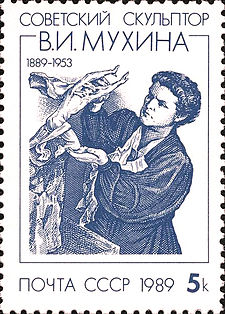- Vera Mukhina
-
Vera Ignatyevna Mukhina (Russian: Вера Игнатьевна Мухина; Latvian: Vera Muhina; 1 July [O.S. 19 June] 1889 in Riga – 6 October 1953 in Moscow) was a prominent Soviet sculptor.
Contents
Life
Mukhina was born in Riga into a wealthy merchant family, and lived at Turgeneva st. 23/25, where a memorial plaque has now been placed. She later moved to Moscow, where she studied at several private art schools, including those of Konstantin Yuon and Ilya Mashkov. In 1912 she traveled to Paris, where she attended the Académie de la Grande Chaumière and took lessons from Emile-Antoine Bourdelle, then continued on to Italy to explore the art and sculptures of the Renaissance period.
In 1915 and 1916 she served as assistant to Aleksandra Ekster at Alexander Tairov's Chamber Theater in Moscow. In 1918 she married Alexei Zamkov, a military surgeon.
In the 1920s Mukhina rose to become one of the Soviet Union's most prominent sculptors, and although she continued to produce cubist sculpture as late as 1922, she became a leading figure of Socialist realism, both in style and ideology. She taught at the state school, Vkhutemas, in 1926-1927, and came to international attention with the 1937 Worker and Kolkhoz Woman. Her studio's work on official monuments and architectural sculpture on state commissions continued through her death. She also experimented with glass, producing glass figural busts. According to legend, the classic Soviet faceted table-glass was designed by Mukhina.
From 1941 to 1952 Mukhina won the Stalin Prize five times, was named People's Artist of the USSR in 1943. In 1953 she wrote "A Sculptor's Thoughts".Because of Muhkina's influence as a great Soviet artist, and as a former student of the Latvian sculptor Kārlis Zāle, she persuaded Soviet officials in the late 1940s that the Freedom Monument in Riga was of great artistic importance. Due to her efforts the monument was not demolished to make way for a statue of Joseph Stalin.
Mukhina's legacy seems to be of little importance to the powers-that-be in today's Moscow. Mukhina's house and studio at 3a Prechistensky Lane is slated for demolition. She's buried at the Novodevichy Cemetery.
 Monument to Vera Mukhina in Moscow
Monument to Vera Mukhina in Moscow
Work
Mukhina's most celebrated work by far is the giant monument Worker and Kolkhoz Woman which was the centerpiece of the Soviet pavilion at the 1937 International Exhibition in Paris.[1] It was the world's first welded sculpture.[2]The 24-meter-tall, 75-ton monument was made of plate of stainless steel on a wooden frame, the plates connected by an innovative method of spot welding. One hand of each figure holds respectively a hammer and a sickle, the two implements joining to form the hammer and sickle symbol of the Soviet Union. In 1947 the sculpture, now on permanent display at the All-Russia Exhibition Centre, became the logo of the Russian Mosfilm studio. It was renovated and re-installed on a higher pedestal in 2009.
Muhkina's other work includes:
- 1927 Peasant Woman, freestanding bronze, now at the Tretyakov Gallery in Moscow
- the 1934 Fertility and 1939 Bread, both now standing in Moscow's Friendship Park
- three cornice figures on the pediment of the Winter Theater in Sochi, 1937
- the monumental group We Demand Peace, 1950-1951 (Mukhina served as coordinator of other sculptors and contributor; her figure is the mourning mother)
- the 1952 Maxim Gorky Monument in Nizhny Novgorod
- the statue of Tchaikovsky in front of the Moscow Conservatory
- the finial figure of Mir ("Peace"), with armillary sphere and dove, for the 1954 Volgograd Planetarium
Honours and awards
- This article incorporates information from the equivalent article on the Russian Wikipedia.
- Stalin Prizes
- first class (1941) - for the sculptural group "Worker and Collective Farm Girl" at the Agricultural Exhibition (1937);
- second class (1943) - a sculptural portraits of Colonels BA Yusupov and IL Khizhnyak (1942);
- first class (1946) - a sculptural portrait of Krylov;
- second class (1951) - for the sculptural group "We demand peace!" (Et al);
- first class (1952) - a monument to Maxim Gorky in Moscow;
- People's Artist of the USSR (1943);
- Order of the Red Banner of Labour (1938);
- Order of the Badge of Honour (1945);
- Order "Citizenship Award" (Bulgaria)
References
- ^ Richard Overy, The Dictators: Hitler's Germany, Stalin's Russia, p260 ISBN 0-393-02030-4
- ^ The history of welding (Russian)
Sources
Categories:- 1889 births
- 1953 deaths
- Burials at Novodevichy Cemetery
- People from Riga
- People from Livonia
- Russian sculptors
- Russian artists
- Soviet sculptors
- Socialist realism artists
- Stalin Prize winners
- People's Artists of the USSR (visual arts)
- Recipients of the Order of the Red Banner of Labour
- Recipients of the Order of the Badge of Honour
- Alumni of the Académie de la Grande Chaumière
Wikimedia Foundation. 2010.


